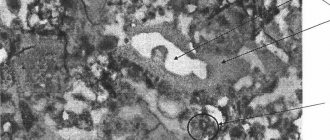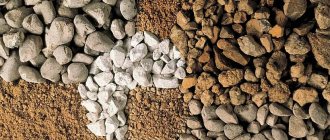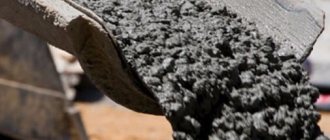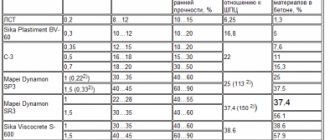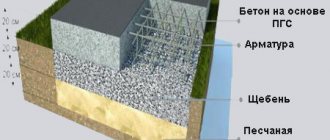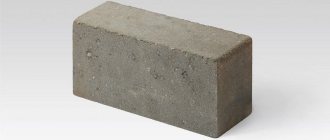X
Depending on the intended purpose of the solution, calculate how much crushed stone to add to 1 m³ of concrete. The reasons for adding crushed stone to concrete are to reduce cost and increase the strength of the finished mixture.
Granite or diabase stone enhances frost resistance and resistance to compressive loads. Its volume is determined depending on the brand of concrete being prepared, for example, m200 or m500, with different ratios and weights of the components.
Crushed stone is produced by crushing solid rock from granite, limestone, gravel, diabase or other rocks. Light stones are mined: tuff, limestone. Slag from blast furnaces and open-hearth furnaces and construction waste are also added to the solutions. When grinding, different fractions and flakiness are obtained. After grinding, they are calibrated through a sieve with different mesh sizes, dividing them by size.
Helpful information:
- Grinding concrete with a grinder
- How much does a cube of concrete weigh?
- How long does it take for concrete to gain strength?
- Concrete substitute and its advantages
- How much money does a washing machine consume?
- Fiber fiber for concrete: a marketing scam or not
Standard stone sizes:
- 70-20 mm – for pouring a monolith;
- 70-40 mm – for massive reinforced concrete structures;
- 60-25 mm – for railways;
- 40-20 mm – mortar for foundations for heavy industrial buildings;
- 20-10 mm - placed in concrete for pouring the foundation for a house, building a roadway;
- 10-5 mm – for the production of floor slabs;
- Gran screening – for casting concrete decor with a washed surface effect.
The shape of the grain is of great importance. The cuboid shape is considered the best, as it provides reliable adhesion inside the solution. Round gravel will weaken the strength of the mortar, while sharp or needle-shaped gravel will make the surface rough. Ideally, cube-shaped grain is used with the partial addition of needle-shaped or flat-flaky crushed stone.
Types of concrete mixtures
Concrete mixtures are classified according to the consumption of sand and crushed stone:
- Lightweight - 1 cubic meter of concrete weighs from 500 to 1800 kg. The weight depends on how much crushed stone is in the concrete cube and what kind of stone was poured. Here they use crushed stone made from tuff, shell rock, and expanded clay, the mass of which is several times lower than their granite counterpart. The amount of crushed stone laid is no more than the weight of sand, which is the binder. The fraction in this case is 5-10 mm. Light mortar is used for the construction of floors, as well as for the manufacture of slag concrete and expanded clay blocks. Walls made of them have heat-insulating properties;
- Heavy - for 1 cubic meter of concrete you need about 1200 kg of crushed stone. The mass of a cubic meter is from 1600 to 2500 kg. This solution is the most popular in the construction of private houses. Gravel or granite stone is laid in a larger fraction - 10-20 mm. Monolithic walls and foundations are poured from heavy concrete;
- A particularly strong , super-heavy mixture, the weight of a cubic meter reaches 3000 kg. This is due to the use of high-density crushed stones, for example, barite or magnetite rocks. Metal slag (scrap) is often added. This solution is suitable for heavy foundations for industrial buildings and high-rise buildings. It is used for the construction of power plants and military facilities.
Characteristics of concrete
The type and quantity of components mixed to create heavy concrete directly depends on the properties that need to be obtained in the end:
- Strength is the most important characteristic, reflecting the ability to prevent destruction as a result of exposure to external factors. The class of concrete according to this indicator ranges from B3.5 to B60, which makes it indispensable in the construction industry. The strength grade of the building composition ranges from M50 to M1000 (from 5 to 100 MPa).
- Temperature resistance, fire resistance is a property of concrete that allows products not to change as a result of exposure to high temperatures. The maximum permissible temperature for concrete, above which the material will be subject to destruction, is 500 degrees, but its strength disappears already at 200 degrees. For a floor area of 1 m, filled with heavy concrete, there is up to 0.5 mm of expansion.
- Water resistance and frost resistance are indicators that together affect the reliability and duration of operation of reinforced concrete products. The first indicator indicates the material’s ability to resist water pressing on the surface. This important property allows the use of heavy concrete in the construction of bridges and canals. Resistance to low temperatures is determined by the number of freezes, after which the strength remains unchanged.
Laminate - calculation of the number of boards
How much crushed stone is needed for 1 cubic meter of concrete?
First, they determine what brand of concrete they want to obtain, and then calculate how much crushed stone is needed per cubic meter of concrete. Special tables indicate the calculated proportions of water, cement, crushed stone and sand in a cube of concrete.
Sand-gravel concrete (SGMC)
According to the technological recommendations for preparing the solution, the amount of crushed stone that should be laid in one cube of concrete is determined. The average rate is 9 parts, of which 1 portion is cement, 3 portions are sand, 5 portions are crushed stone. The proportion looks like this: 1:3:5.
The weight value depends on the fraction and density of the stone. The average mass of crushed stone in 1 cube of concrete is 1400 kg. To avoid voids in the finished structure, it is recommended to take several fractions at once, of different flakiness, so that the stone is evenly distributed in the mixture.
Home preparation of the solution is impossible due to the large volume and weight in one cube of concrete. Therefore, proportions are given for a small batch, taking a bucket as a unit of measurement.
The proportion is the same 1:3:5. That is, 1 bucket of Portland cement 500, 3 buckets of sand, and the amount of crushed stone is 5 buckets. At home, in addition to the large fraction of 10-20, a certain amount of grains of screening is added, which improves the filling of strip foundations.
For very small volumes of solution, the bulk components are measured with a shovel in the same proportion of 1:3:5.
Before mixing the components, it is necessary to measure the weight of the unit, for example, one bucket of filler, in order to more accurately calculate the proportion of weight.
Calculated values
Starting the calculation on the calculator: the amount of concrete that needs to be obtained for construction work is indicated. Its weight is calculated in cubic meters. You can calculate heavy concrete in various volumes - from industrial to small, by first converting the number of liters into a cubic meter (for example, 40 l = 0.04 m3).
Concrete strength grades in calculation
The most important conditions for obtaining the required grade of cement mortar are the correct choice and accuracy of calculation of the components. The quality and purpose of concrete depends on the proportions calculated:
- Brand M500 serves as the best basis for the construction of foundations for industrial facilities, special buildings, structures and hydraulic structures.
- M250 - M350 - used for strip foundations in private construction, walls in apartment buildings, as well as slab foundations.
- M150 – M200 – suitable for the construction of light structures in individual construction.
- M50 - M150 - used in finishing works, when arranging areas (landscape design).
The calculation formula for preparing the concrete composition is recommended by the methodology prescribed in GOST 27006 - 86 (1989) “Concrete. Rules for the selection of compositions" and GOST 7473 - 94 "Concrete mixtures. Technical conditions".
Composition and proportions of aggregates
The characteristics of the concrete mixture depend on the accuracy of the calculations of cement, gravel, and water, so the online calculator will become a convenient tool for calculating the proportions in cubes.
When using a solution, it is important to consider the size of the fractions, the ratio of sand, crushed stone or gravel. The properties of heavy concrete will depend on the following types of aggregates used simultaneously:
- large - these include crushed stone (granite, limestone, slag) or gravel. They are responsible for stability and also give less shrinkage after concrete is cast.
- fine sand is quarry, river or expanded clay types. Its presence in the mixture removes porosity and increases the density of concrete. The size of the grains of sand affects the water resistance and density of concrete: the smaller, the better and stronger.
How to make concrete flowerpots that the whole family will love
When creating a concrete mixture, it is important to adhere to exact proportions. They determine the durability of the work performed and act as a guarantee of quality.
Cement brand
Cement is the material that binds all components together. The choice of brand depends on the concreting technology, type of concrete and solution consumption in m3. In case of violation of the proportion, the cement affects the short-term operation, which entails repeated work.
In Portland cement (for example PC 500), the amount of various impurities is kept to a minimum, so additional ingredients will only improve the quality of the concrete mixture. It is convenient and easy to prepare such cement; it is very affordable. The grade of cement indicates the maximum compressive strength in kg per square meter.
Mobility of concrete mixture
Mobility is the ability of the solution to effectively fill the formwork. It indicates the ease of working with the mixture and the quality of compaction. Filling the mold for pouring the site is done using compaction, vibration, or simply under its own weight. There are the following categories of concrete mobility:
- Zh1 and Zh2 are rigid mixtures of concrete used in the construction of civil and industrial facilities, reinforced concrete structures, as well as support platforms. The use of vibration devices for shrinkage is mandatory.
- P1 - used in the construction of thin walls, supports, slabs with reinforcement of no more than 1%. Casting is accompanied by a manual or mechanical seal.
- P2 - used for products with reinforcement of more than 1% - beams, bridge parts or in private construction - for the manufacture of garage floors, giving them special strength. Compaction is done manually or technically.
- P3 - such a solution fills space well, but is not yet flexible enough to fill complex shapes without using vibration technology. Suitable for individual and commercial construction.
- P4 – concrete easily fills cavities on its own, without additional shrinkage equipment. You can use a concrete pump. This solution saves time on filling the site and simplifies it.
When using less flexible grades of concrete, you should not increase the amount of water, deviating from the recommended proportions. This will increase the elasticity of the mixture and the rate of shrinkage, but construction standards will be violated, which will lead to a decrease in strength, the appearance of cracks and even destruction. It is worth using concrete mixtures with characteristics corresponding to the type of structures being built.
The presence of plasticizers, in addition to the main purpose of increasing the plasticity of the solution, contributes to the effective movement of sand-gravel mixtures and various fillers, which ensures high-quality casting. This has a positive effect on the structure of concrete, removing excess air from the composition. Plasticizers are an essential ingredient in high-end construction projects.
Pipe length calculator for corrugated gates
How much does it cost to pour a cube of concrete by hand?
Doing it manually will be slow and difficult, which is why it is better to choose this method if:
- it is necessary to fill a small area;
- you have serious intentions to save money (or simply don’t have any).
The sequence of actions is as follows:
There are 5 types of concrete mixers common in Russia. It is noteworthy that the technological process differs from manual kneading in the sequence of loading the components; each type of mixer has its own.
“Old-father method” or current SNiP?
Experience is a good thing, but we should not forget about building regulations. They take into account all the factors associated with the preparation of mortars and concrete (purity, coarseness, moisture content of sand and crushed stone, cement activity and water quality).
Therefore, when preparing for work on pouring a foundation, screed or laying walls, do not be lazy to look at the GOST tables. You only need one or two lines in them. They clearly describe what the cement consumption per cube of mortar should be to obtain the required strength (grade).
Here is a simple “squeeze” from SNiP, which will help prepare a high-quality mortar for masonry and screed . After studying it, remember that the given consumption rates differ slightly from practical values.
Cement brand
Brand of solution
Cement consumption rate for making 1 m3 of mortar
The reason is that they are produced from standard preparation conditions (air temperature +23C, medium-grained sand, ideally clean, its humidity no more than 7%, etc.). It is not realistic to ensure standard parameters for mixing at a construction site, so it is better to purchase cement with a small reserve (10-15%).
The answer to the question of how much cement and sand you need per cube of concrete will be given by the following standards:
Concrete grade
Cement consumption M500 kg/1m3
When making concrete, it is important to know not only the amount of cement, but also the standard volume of sand and crushed stone. The following table will be useful for calculations.
Volumetric proportions for various grades of concrete
Concrete, brand
Ratio of cement/sand/crushed stone in liters
cement M 400
cement M 500
The required sand consumption per 1 m3 of solution is 1 cubic meter . Some developers are mistaken in believing that the volume of cement increases the volume of the finished mixture. This is wrong. The cement is very finely ground, so it is distributed in the voids between the sand, without increasing the total volume of concrete and mortar. Therefore, for 1 m3 of sand we can add 200 and 400 kg of cement, obtaining the same 1 cubic meter of solution.
